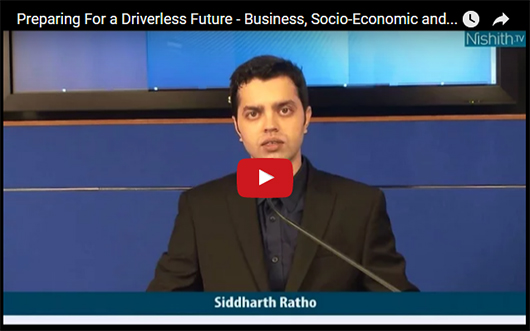|
|
Preparing For a
Driverless Future |
|
|
|
Business, Socio-Economic and Legal Perspectives |

|
| |
|
July 7, 2016
|
|
Very recently, a driver using the autopilot mode in a Tesla Model S was killed in an accident, leading to an array of legal complexities, ethical conundrums, and sparking debates on the question of liability in such a situation. Regulators in the United States are currently investigating this death, which is the first of its kind. While the said investigation is still underway, it is clear that the legal, ethical and practical issues relating to the common usage of autonomous vehicles are already here, and are very real, and need to be addressed appropriately if the transition into the driverless age is to be as smooth as possible. Our
Automotive Practice Group is therefore pleased to present the above publication, accessible through this
thumbnail, which is intended to provide thought-stimulating insights on the burgeoning autonomous vehicular industry and the uniquely new issues that already exist, and are bound to continue to arise as the driverless future arrives in its full glory.
While incidents such as the Tesla car crash may increase political pressure to tighten the regulation of automated functions in a vehicle, thereby possibly slowing down the development of such a technology, it is evident that the next chapter in mobility is soon to be written and if corporations and governments intend to tap into its full potential, they must prepare accordingly. This paper provides a global and a domestic overview on the status of autonomous vehicles as they currently stand, existing laws and their limitations, how the idea spread, and the practical challenges in its real world implementation, while also providing a glimpse into the driverless future.
For any help or assistance please email
us on
autopractice@nishithdesai.com.
Do visit us at
www.nishithdesai.com.
|
|
|
| |
|

|
 |
|
Key Points
|
|
The following key points shall provide a brief
synopsis of what this publication covers;
-
The driverless car will most likely join unmanned
drones and digital surveillance as one of the
advances and controversies of our times
-
Companies such as Tesla Motors, Google, Apple,
TomTom, Baidu, Faraday Future, BMW and Jaguar
Land Rover are already looking to become key
players in the driverless space
-
Soon enough there will no way of distinguishing
technology and software companies from automobile
companies, as collaborations between the two
will blur all boundaries between them.
-
Currently, automated features in cars are controlled
by a central unit called the ECU (engine control
unit). The functioning of the fully autonomous
vehicle promises to elevate existing technology
to much more advanced levels.
-
The paper uses the Triple Bottom Line framework,
an accounting framework that incorporates three
dimensions of performance: social, environmental
and economic and evaluates the autonomous vehicles’
potential against the said framework.
-
An amendment was made in 2014 to Article 8 of
the Vienna Convention on Road Traffic, 1968
allowing for the car to drive itself as long
as the system “can be overridden or switched
off by the driver”. As a result, various
countries around the world have now begun taking
measures to confront the inevitable reign of
the autonomous vehicle, which is discussed in
the publication
-
Legal ramifications relating to the following
are discussed;
-
Relevant / Applicable laws in India
-
India’s own unique challenges to implementation
such as cultural nuances, inadequate infrastructure
and inadequate legislation have been discussed
-
A glimpse into the future has been provided
At Nishith Desai Associates, it is our constant
endeavor to be future ready. No one can truly predict
the lightening pace of technological advancement
in the current age. However, one can make safe estimations
and prepare accordingly.
Hope you have a good read and we look forward to
your feedback!
Automotive Practice Group
Nishith Desai Associates
Legal 500: Ranked in
Tier 1 for Investment Funds and International Taxation
Fastest Growing M&A
Law Firm in India in 2015: MergerMarket
The Most Innovative
Law Firm in Asia-Pacific

|
|
|
|
|
Nishith Desai Associates
announced ‘Most Innovative Law Firm in
Asia-Pacific’ by Financial Times
in its FT Asia-Pacific Innovative Lawyers
2016 report
Nishith Desai Associates
has been declared as the Most Innovative
Indian Law Firm (2015) at the Innovative
Lawyers Asia-Pacific Awards by the Financial
Times - RSG Consulting
|
| |
|
|
If you have passion
to change the world - for the better,
if you have flair for innovation, if
you have client centricity and obsession
to provide 'wow' service to them, if
you have extra-ordinary skill and enthusiasm
for research and writing, if you have
the urge to undertake challenging work,
if you are a risk taker and have long-term
goals, if you want to walk the extra-mile
to help the needy- And if you believe
we are not in the 'business of law'
but in the 'profession of law', please
write to
happiness@nishithdesai.com.
To learn more about
us
Click here.
|
|
|
